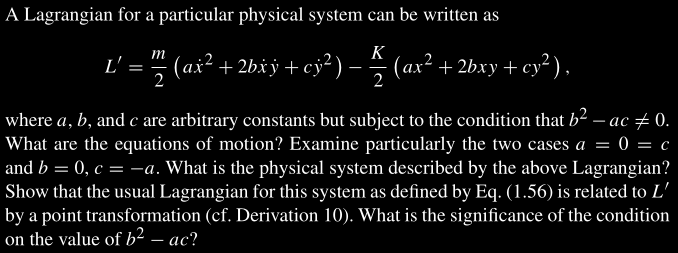Post History
$$L'=\frac{m}{2}(a\dot{x}^2+2b\dot{x}{y}+c\dot{y}^2)-\frac{k}{2}(ax^2+2bxy+cy^2)$$where a, b, and c are arbitrary constants but subject to the condition that $b^2 − ac \ne 0$. What are the equat...
#1: Initial revision
Find equation of motion using. Lagrangian given equation is $L'=\frac{m}{2}(a\dot{x}^2+2b\dot{x}{y}+c\dot{y}^2)-\frac{k}{2}(ax^2+2bxy+cy^2)$
>$$L'=\frac{m}{2}(a\dot{x}^2+2b\dot{x}{y}+c\dot{y}^2)-\frac{k}{2}(ax^2+2bxy+cy^2)$$<br/>where a, b, and c are arbitrary constants but subject to the condition that $b^2 − ac \ne 0$.
What are the equations of motion? Examine particularly the two cases $a = 0 = c$
and $b = 0$, $c = −a$. What is the physical system described by the above Lagrangian?
Show that the usual Lagrangian for this system as defined by Eq. (1.56) is related to $L'$
by a point transformation (cf. Derivation 10). What is the significance of the condition
on the value of $b^2 − ac$?<br/><br/>$L=T-U \ \text{Eq.(1.56)}$
It's two dimensional. If there was only $x$ than, it was easier to differentiate. But, I was thinking what I should do now. Then, all the things I had done that is differentiating respect to $x$ and $y$ both.
$$\frac{d^2 L}{dx dy}=-kax-bkx-bky-cky$$
$$\frac{d^2 L}{d\dot{x}d\dot{y}}=am\dot{x}+bm\dot{y}+bm\dot{x}+cm\dot{y}$$
$$\frac{d}{dt}(\frac{d^2 L}{d\dot{x}d\dot{y}})=am\ddot{x}+bm\ddot{y}+bm\ddot{x}+cm\ddot{y}$$
$$\frac{d}{dt}(\frac{d^2 L}{d \dot{x} d\dot{y}})-\frac{d^2}{dxdy}=0$$
$$am\ddot{x}+bm\ddot{y}+bm\ddot{x}+cm\ddot{y}=-(kax+bkx+bky+cky)$$ How can I find equation of motion for that? (`What are the equations of motion?`) Should I find a equation for $x$ at first then another equation for $y$?


















